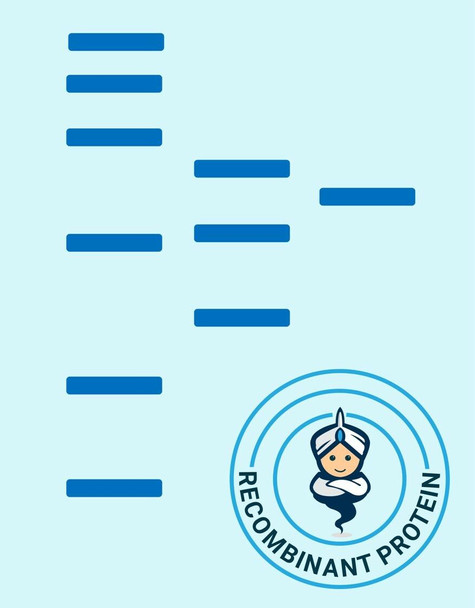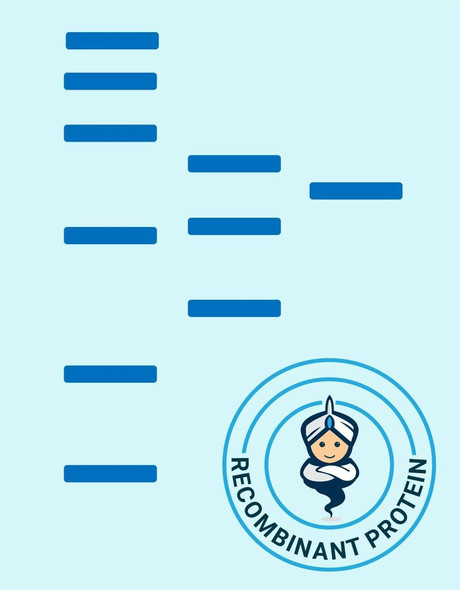Description
| Product Name: | Human GRO a Recombinant Protein |
| Product Code: | RPPB1141 |
| Size: | 25µg |
| Species: | Human |
| Target: | GRO a |
| Synonyms: | Growth-regulated protein alpha, CXCL1, Melanoma growth stimulatory activity, MGSA, Neutrophil-activating protein 3, NAP-3, GRO-alpha (1-73), chemokine (C-X-C motif) ligand 1, GRO1, GROa, SCYB1, MGSA-a, MGSA alpha. |
| Source: | Escherichia Coli |
| Physical Appearance: | Sterile Filtered White lyophilized (freeze-dried) powder. |
| Formulation: | Lyophilized from a 0.2�m filtered concentrated (1mg/ml) solution in 20mM PB, pH 7.4, 50mM NaCl. |
| Solubility: | It is recommended to reconstitute the lyophilized CXCL1 in sterile 18M?-cm H2O not less than 100�g/ml, which can then be further diluted to other aqueous solutions. |
| Stability: | Lyophilized GRO-alpha although stable at room temperature for 3 weeks, should be stored desiccated below -18°C. Upon reconstitution CXCL1 should be stored at 4°C between 2-7 days and for future use below -18°C. For long term storage it is recommended to add a carrier protein (0.1% HSA or BSA).Please prevent freeze-thaw cycles. |
| Purity: | Greater than 97.0% as determined by:(a) Analysis by RP-HPLC.(b) Analysis by SDS-PAGE. |
| Amino Acid Sequence: | The sequence of the first five N-terminal amino acids was determined and was found to be Ala-Ser-Val-Ala-Thr |
| Biological Activity: | Determined by its ability to chemoattract human peripheral blood neutrophils using a concentration range of 10.0-100.0 ng/ml. |
Chemokine (C-X-C motif) ligand 1 (CXCL1) is a small cytokine belonging to the CXC chemokine family that was previously called GRO1 oncogene, Neutrophil-activating protein 3 (NAP-3) and melanoma growth stimulating activity, alpha (MSGA-a). It is secreted by human melanoma cells, has mitogenic properties and is implicated in melanoma pathogenesis. CXCL1 is expressed by macrophages, neutrophilsand epithelial cells, and has neutrophil chemoattractant activity. CXCL1 plays a role in spinal cord development by inhibiting the migration of oligodendrocyte precursors and is involved in the processes of angiogenesis, inflammation, wound healing, and tumorigenesis. This chemokine elicits its effects by signaling through the chemokine receptor CXCR2. The gene for CXCL1 is located on human chromosome 4 amongst genes for other CXC chemokines.
GRO Alpha Human Recombinant produced in E.Coli is a single,non-glycosylated, polypeptide chain containing 73 amino acids and having a molecular mass of 7811 Dalton. The GRO-alpha is purified by proprietary chromatographic techniques.
| UniProt Protein Function: | CXCL1: Has chemotactic activity for neutrophils. May play a role in inflammation and exerts its effects on endothelial cells in an autocrine fashion. In vitro, the processed forms GRO- alpha(4-73), GRO-alpha(5-73) and GRO-alpha(6-73) show a 30-fold higher chemotactic activity. Belongs to the intercrine alpha (chemokine CxC) family. |
| UniProt Protein Details: | Protein type:Motility/polarity/chemotaxis; Secreted, signal peptide; Secreted Chromosomal Location of Human Ortholog: 4q21 Cellular Component: extracellular space; extracellular region Molecular Function:growth factor activity; chemokine activity; CXCR chemokine receptor binding; enzyme activator activity; receptor binding Biological Process: positive regulation of catalytic activity; G-protein coupled receptor protein signaling pathway; cell proliferation; nervous system development; negative regulation of cell proliferation; immune response; response to lipopolysaccharide; positive regulation of leukocyte chemotaxis; inflammatory response; actin cytoskeleton organization and biogenesis; chemotaxis; signal transduction |
| NCBI Summary: | This antimicrobial gene encodes a member of the CXC subfamily of chemokines. The encoded protein is a secreted growth factor that signals through the G-protein coupled receptor, CXC receptor 2. This protein plays a role in inflammation and as a chemoattractant for neutrophils. Aberrant expression of this protein is associated with the growth and progression of certain tumors. A naturally occurring processed form of this protein has increased chemotactic activity. Alternate splicing results in coding and non-coding variants of this gene. A pseudogene of this gene is found on chromosome 4. [provided by RefSeq, Sep 2014] |
| UniProt Code: | P09341 |
| NCBI GenInfo Identifier: | 121622 |
| NCBI Gene ID: | 2919 |
| NCBI Accession: | P09341.1 |
| UniProt Secondary Accession: | P09341,Q9UCR7, |
| UniProt Related Accession: | P09341 |
| Molecular Weight: | |
| NCBI Full Name: | Growth-regulated alpha protein |
| NCBI Synonym Full Names: | chemokine (C-X-C motif) ligand 1 (melanoma growth stimulating activity, alpha) |
| NCBI Official Symbol: | CXCL1�� |
| NCBI Official Synonym Symbols: | FSP; GRO1; GROa; MGSA; NAP-3; SCYB1; MGSA-a�� |
| NCBI Protein Information: | growth-regulated alpha protein; MGSA alpha; GRO-alpha(1-73); C-X-C motif chemokine 1; fibroblast secretory protein; neutrophil-activating protein 3; melanoma growth stimulatory activity alpha; GRO1 oncogene (melanoma growth-stimulating activity); GRO1 oncogene (melanoma growth stimulating activity, alpha) |
| UniProt Protein Name: | Growth-regulated alpha protein |
| UniProt Synonym Protein Names: | C-X-C motif chemokine 1; GRO-alpha(1-73); Melanoma growth stimulatory activity; MGSA; Neutrophil-activating protein 3; NAP-3 |
| Protein Family: | Growth-regulated alpha protein |
| UniProt Gene Name: | CXCL1�� |
| UniProt Entry Name: | GROA_HUMAN |






